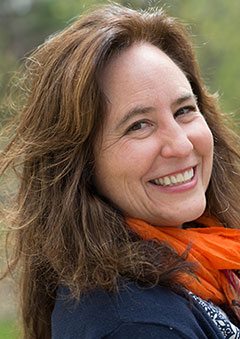
While taking a closer look at Creekfinding: A True Story, it is impossible to separate the narrative and the illustrations because together they make the book whole. And yet two different artists created the words and the illustrations that guide the reader toward an understanding of the Brook Creek restoration project. Claudia McGehee notices the details, the encompassing emotions and the nuances of the landscape that encourage to walk alongside Team Brook Creek while they explore this restored ecosystem. Do add this book to your bookshelves. You’ll want to read it and soak in the art whenever you need reassurance that we can be good stewards of this Earth..
When you begin work on a new book, what is the first thing that you do?
I find a quiet place to read the manuscript several times, close my eyes, and imagine the “scenes” the words bring forth to me, keeping a sketchbook handy to get these “first blinks” of inspiration. This goes for when I have authored the book as well; I don’t start illustrating until the manuscript is complete.
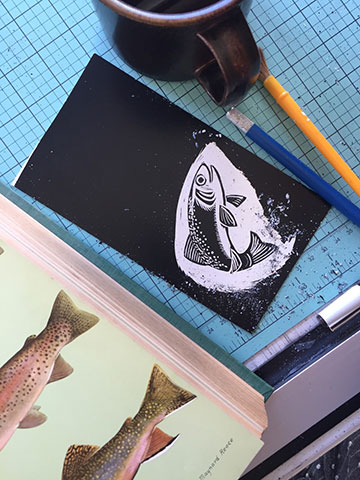 In the Illustrator’s Note, you state, “I made the ripply, sturdy lines of earth, water, and sky in scratchboard and painted the prairie greens, creek blues, and everything in between with watercolors and dyes.” Can you tell us a bit about the tools you use for scratchboard?
In the Illustrator’s Note, you state, “I made the ripply, sturdy lines of earth, water, and sky in scratchboard and painted the prairie greens, creek blues, and everything in between with watercolors and dyes.” Can you tell us a bit about the tools you use for scratchboard?
I use a sharp skinny X-acto blade (a number 16, with a beveled end) to carve into the scratchboard surface, revealing the white chalky layer below. I scratch out what I want to be white or colored, and leave an outline and detail in black. When all the line-work is complete, I scan the image into my Mac and print it onto watercolor paper. From here I use watercolor and dyes and paint traditionally at my board.
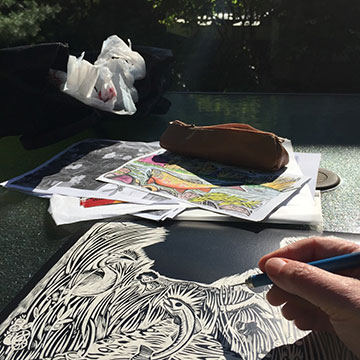 For readers who would like to work with scratchboard, what type of paper do you use? What do you mean by dyes? How do you apply them to the paper? And why do you use them?
For readers who would like to work with scratchboard, what type of paper do you use? What do you mean by dyes? How do you apply them to the paper? And why do you use them?
I use Essdee brand scratchboard. It is robust enough to be scratched, inked again if I want to make a correction and reworked. There is also a thinner grade of scratchboard (the company Melissa and Doug makes this kind) that younger people can scratch with wooden stylus, much less sharp than an X-acto blade.
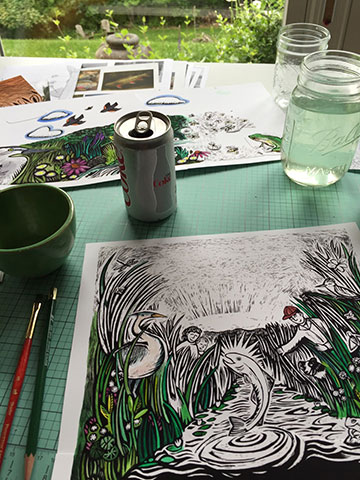 The dyes go by the brand name Dr. Ph. Martin’s. They’ve been around forever. They are essentially watercolor, known for their vivid, almost fluorescent quality. I apply them just as I do watercolors, with a brush. They work very well for prairie and creekside flowers and critters. I am very partial to the Doc Martin chartreuse (frog green!). The dyes do tend to fade in the sunlight, so I keep my originals in dark file drawers to preserve the color.
The dyes go by the brand name Dr. Ph. Martin’s. They’ve been around forever. They are essentially watercolor, known for their vivid, almost fluorescent quality. I apply them just as I do watercolors, with a brush. They work very well for prairie and creekside flowers and critters. I am very partial to the Doc Martin chartreuse (frog green!). The dyes do tend to fade in the sunlight, so I keep my originals in dark file drawers to preserve the color.
How do you preserve and store scratchboard artwork?
I have a large, older, flat file where a lot of work goes. I also archive in big plastic bins, separating the artwork by each individual book project.
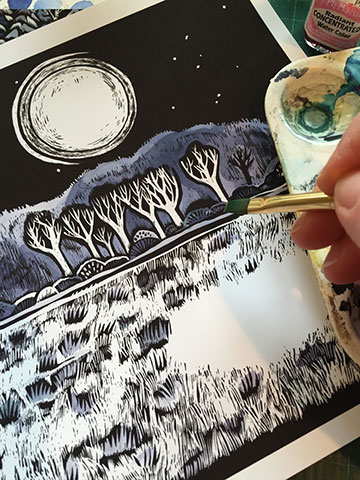 At what point in the making of the book do you create the endpapers?
At what point in the making of the book do you create the endpapers?
A highlight for me is to behold a picture book’s end-sheets. Good ones will give an indication of the book’s overall message or spirit. Sometimes they tell a story as well. I savor making my own end-sheets, usually treating myself to making them at the very last of a book project. The Creekfinding end-sheets are something I’ve wanted to try for a while, using them to suggest a passage of time. The opening of the book is a sunrise on the creek, complete with red-winged black bird, and the back sheet is a sunset.
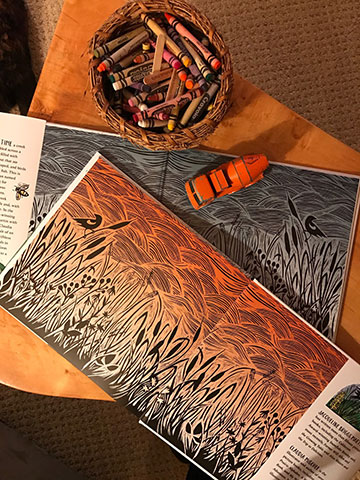 You visited Prairie Song Farm, which is where the creek in this book was restored. As an artist, how do you look at a new location that you will make the focus of a new book?
You visited Prairie Song Farm, which is where the creek in this book was restored. As an artist, how do you look at a new location that you will make the focus of a new book?
I simply try to observe and be in the moment when I visit a book setting’s location. I want the place to speak to me and I have to be quiet to hear it. My work relies on small details that make the setting unique. Hopefully, my impressions will pass on successfully to my illustrations later in the studio.
You have a degree in archaeology. What does the knowledge you studied bring to the work you do now?
In a practical sense, my archaeology background helped me hone my research skills, as important to an illustrator as they are to a writer. There is also a level of basic curiosity in the archaeologist, a love for the “what comes next?” that is similar in the process of making a nonfiction-based picture book.
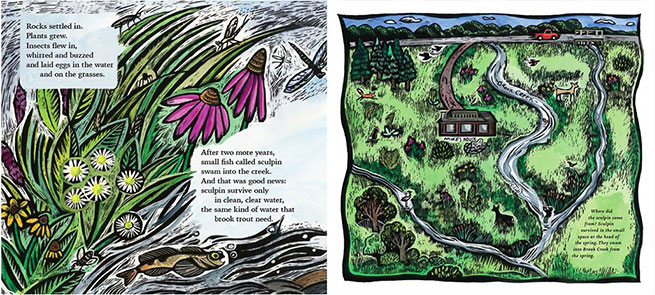
The humans, birds, fish, and insects in this book all look joyful. Was that a conscious decision on your part?
I may never work for National Geographic, but I believe that all animals are capable of “smiling” and showing happiness like humans do and I naturally want to show this. After all, I would be happy if I were a brook trout in Mike’s creek! I don’t want them to look too sweet or whimsical however, but I do hope my birds and fish et al express a sense of joy in living that all creatures feel.
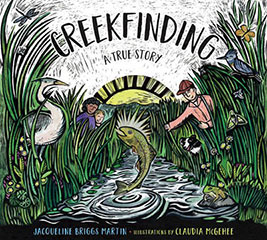 The art in this book is gorgeous, sumptuous, an invitation to revel in our natural landscapes. What do you feel while you’re working on a book like this? And once it’s printed and in your hands?
The art in this book is gorgeous, sumptuous, an invitation to revel in our natural landscapes. What do you feel while you’re working on a book like this? And once it’s printed and in your hands?
Thank you! I really am taken by our natural world’s beauty. It sustains me. My personal art mission is for my work to entice readers outdoors after a good read to experience nature themselves.
Actually making book art is not as magical a time as some imagine! It is hard physical and mental work. Publishing deadlines are critical to make, so at times I feel I am a marathon runner, pacing herself through a long race. There are certainly points of joy, like the completion of thumbnails or sketches. I will laugh out loud if I feel I have really nailed a spread. But there are also frustrations when I just can’t get a page to come together.
The best part of making Creekfinding is that Jackie and I live quite close and are friends and we regularly connected to share the progress of the book. I looked at early versions of her manuscript and she looked at the artwork in progress. It was nice to have this camaraderie, and what we later called “Team Brook Creek,” which includes Mike Osterholm, the book’s subject. It was truly a unique project to be part of.
Thank you, Claudia for sharing with us an inside look at the incredible work you do.
Don’t miss the companion interview with author Jacqueline Briggs Martin or the Bookstorm for Creekfinding: A True Story offering companion books and websites for further exploration or incorporation into lesson plans.

Gorgeous illustrations, Claudia! And your contrasting endpapers are stunning!